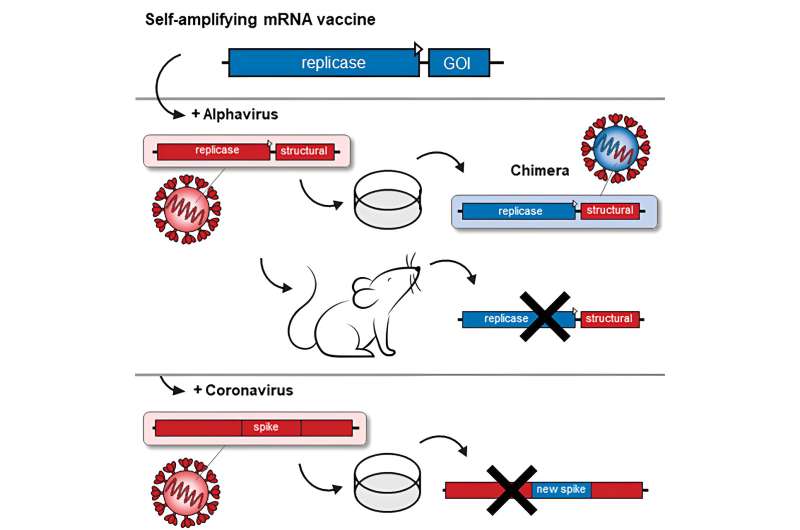This article has been reviewed according to Science X's editorial process and policies. Editors have highlighted the following attributes while ensuring the content's credibility:
fact-checked
peer-reviewed publication
trusted source
proofread
Self-amplifying mRNA vaccines appear safe in lab and animal tests

mRNA vaccines contain instruction codes for making parts of pathogenic viruses. Can so-called self-amplifying types of such vaccines form unwanted and dangerous connections with other viruses? Yes, say Wageningen virologists Tessy Hick and Gorben Pijlman after experimental research. But the practical dangers are negligible.
Classic flu vaccines contain a weakened piece of the flu virus. These stimulate the immune system to recognize the virus and break it down when the virus infection occurs. mRNA vaccines work differently. They do not contain virus pieces, but the construction code to create a virus piece.
After the injection of this mRNA, the body's cells start producing this piece to stimulate the immune system, after which the immune system recognizes the intruders and attacks during a virus infection. A well-known mRNA vaccine is Pfizer's corona vaccine.
Now a new type of RNA vaccine has been developed, the self-amplifying mRNA (SAM) vaccine. This type of vaccine not only produces the instruction code of the protein that activates the immune system, but also the printing press that will produce more copies of the virus piece. This stimulates the immune system in a more efficient way. The study, which was recently published in Molecular Therapy, focused on these SAM vaccines.
Every vaccine must be tested for safety before it goes on the market. The big question with these SAM vaccines is: can the instruction codes of these vaccines recombine with circulating viruses? And if so, does this pose a health or environmental risk?
Hick and Pijlman investigated this risk experimentally for the first time. They tested in the laboratory whether the SAM vaccines exchanged hereditary material with viruses and then looked to see whether they encountered such combinations in laboratory animals.
According to Pijlman, "The vaccines can indeed recombine with viruses under laboratory conditions, resulting in chimeric viruses (mixtures). To achieve this, you have to try very often and the conditions have to be just right. However, we could not detect these chimeric viruses in laboratory animals, which shows that these vaccines are probably safer than you would initially estimate." The results are of great importance for the authorization of new SAM vaccines and gene therapies.
More information: Tessy A.H. Hick et al, Safety concern of recombination between self-amplifying mRNA vaccines and viruses is mitigated in vivo, Molecular Therapy (2024). DOI: 10.1016/j.ymthe.2024.06.019




















